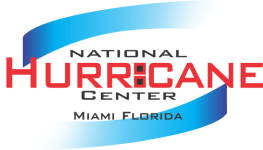#ItOnlyTakesOne
Complete Your Written Hurricane Plan
Get a Plan!
Bryan Koon
Director, Florida Division of Emergency Management
@BKoonFDEM / @FLSERT
A lot of the advice you hear in advance of hurricane season includes some variation on “Get a Plan”. And you may have thought, “Why? How difficult can it be?” The truth is, it’s really not difficult. Most of the things that I want you to consider when dealing with a natural disaster such as a hurricane are basic, common-sense issues that you deal with every day of your life. The problem is that when a hurricane or other severe weather is bearing down on you and your family, the things that you normally take for granted may be in short supply, and you’ve got to get a lot done in a very short period of time. In those circumstances, having gone through the planning process with your loved ones, and developing a written plan to help guide your actions, could save your life.
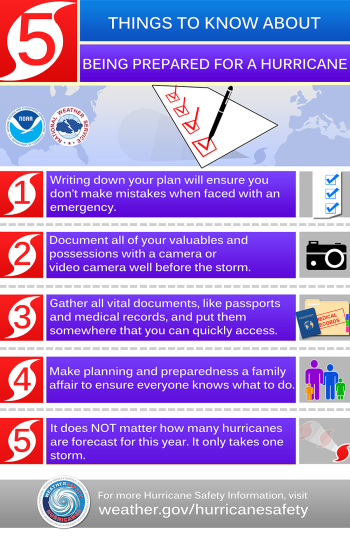 Simply considering developing a plan is a very good first step. It will help you think about the hazards where you live. Are you close to the ocean and potentially in a storm surge zone? Do you live in a flood plain? Do you live in a house likely to be damaged in high winds? Are the roads you rely on to get to the grocery store or the pharmacy prone to flooding? Knowing how a storm can affect you will help determine what kind of plan you should develop.
Simply considering developing a plan is a very good first step. It will help you think about the hazards where you live. Are you close to the ocean and potentially in a storm surge zone? Do you live in a flood plain? Do you live in a house likely to be damaged in high winds? Are the roads you rely on to get to the grocery store or the pharmacy prone to flooding? Knowing how a storm can affect you will help determine what kind of plan you should develop.
Once you know how a hurricane will affect your physical environment, consider what that means for your loved ones. Do you care for young children or elderly relatives? Do you have pets or livestock that you need to care for? Think about how a prolonged period without power or water will affect them. What would you do if you couldn’t get to the grocery store for a few days, or if the gas station ran out of fuel?
Once you’ve thought about these issues, though, take the next step and write down your answers. When a hurricane is coming, having a written plan will help ensure that you’re taking care of the most important things. And by going through the planning process together, you and your family will be more confident that you’ll be able to survive the storm and get your life back to normal as quickly as possible. Having a guide to make sure you’ve taken care of the essentials will give you peace of mind and allow you to focus on keeping your family safe.
Will everything go exactly as you planned it? Probably not. There are so many variables in a hurricane and so many unknown factors that you’ll likely have to improvise. But it’s much easier to deviate from a well-considered plan than it is to try to develop a course of action from scratch during the middle of the event.
There are a lot of resources to help you. In Florida, try www.flgetaplan.com. In South Carolina go to http://www.scemd.org/planandprepare/preparedness/famdiasterplan, and in Texas a good resource is http://www.texasprepares.org/. Other great sites include The Red Cross and FEMA’s Ready.gov site. And there are many more; simply search “disaster plan” on the internet and you’ll find plenty of options. All of them are very good, and any one of them will help you accomplish your goal of getting you ready. Kids can even get involved by helping their parents fill out a family communication plan.
Hurricanes are a fact of life, and their impacts can be catastrophic. If you are well prepared for them however, the likelihood that you will survive and be able to recover quickly are tremendously improved. That preparation starts with developing a plan to guide you through the situation. An hour or two spent now on writing your plan could save your life!
Identify Your Trusted Sources of Information
Identifying Trusted Sources for a Hurricane Event
Dr. Gina Eosco
Senior Social Scientist/Risk Communication Specialist, Eastern Research Group
@WxComm / @ERGupdate
Hurricanes are dangerous! Extreme winds, storm surge, inland flooding from heavy rains, and tornadoes can all be life threatening. Understanding your risk from these threats is important—and a trusted, credible source for hurricane information can help.
 When a storm is threatening your area, there are many places to go for information to determine if you are at risk….
When a storm is threatening your area, there are many places to go for information to determine if you are at risk….
- The National Weather Service, including the National Hurricane Center
- TV stations
- Websites
- Social media
- And others… like friends and family
But, are all sources of weather information the same? Are all sources trustworthy?
To answer that question, you first have to define what is meant by “trustworthy.” As it turns out, several factors contribute to people’s perceptions of trust, including the source’s knowledge and expertise, openness and honesty, and concern and care.[i] Using these factors of trust, here are some tips to identify trusted sources of hurricane information:
Does your source have hurricane knowledge and expertise? Knowledge and expertise are gained through a combination of study and practical experience. Does your source hire staff with degrees in meteorology? In addition to formal degrees, the American Meteorological Society certifies individuals who have “achieved a high level of competency in communicating complex weather.” The National Weather Association also offers a certification program. These certifications and corresponding logos are shown on TV next to a broadcaster’s name, online, or in someone’s biography.
Of equal importance is how many years of experience does your source have? Hurricanes are like fingerprints. No two storms are the same. Forecasters must observe, collect, and analyze complex data to determine the hurricane track, intensity, and potential impacts, like storm surge. It stands to reason that the more experience a source has with different storms, the more knowledge and expertise that individual has gained over time.
Determining if a source is open and honest is a bit more subjective. Here are a few guiding thoughts.
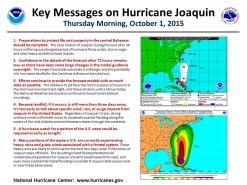 Does your source convey what he or she knows and doesn’t know? There is always some uncertainty with a storm. Communicating uncertainty is vital to an open dialogue about the risk of hurricanes. For example, during Hurricane Joaquin in September and October of 2015, the National Hurricane Center issued a new “key messages” section in their Tropical Cyclone Discussion and also sent it out on Twitter, at one point stating, “Because landfall, if it occurs, is still more than three days away, it’s too early to talk about specific wind, rain or surge impacts from Joaquin in the United States.” NHC openly shared what it did and did not know about the storm.
Does your source convey what he or she knows and doesn’t know? There is always some uncertainty with a storm. Communicating uncertainty is vital to an open dialogue about the risk of hurricanes. For example, during Hurricane Joaquin in September and October of 2015, the National Hurricane Center issued a new “key messages” section in their Tropical Cyclone Discussion and also sent it out on Twitter, at one point stating, “Because landfall, if it occurs, is still more than three days away, it’s too early to talk about specific wind, rain or surge impacts from Joaquin in the United States.” NHC openly shared what it did and did not know about the storm.
The last factor that leads to trust is perceiving that a source has concern and care for you. You might get the impression that a source feels concern and care by his or her tone of voice or word choice—but how do you really know? One way to gauge concern and care is by understanding the source’s mission. For instance, the National Hurricane Center explicitly states that its mission is
“To save lives, mitigate property loss, and improve economic efficiency by issuing the best watches, warnings, forecasts and analyses of hazardous tropical weather, and by increasing understanding of these hazards.”
Hurricanes can be fearful experiences to live through, and evacuation decisions can be equally as stressful. Hurricane risk information from a trusted source can calm those fears and provide the details you need to make an informed decision that is right for you.
Hurricanes may vary in their strength, but with trusted sources by your side, you can always remain #HurricaneStrong.
Reference:
[i] Peters, R. G., Covello, V. T., & McCallum, D. B. (1997). The determinants of trust and credibility in environmental risk communication: An empirical study. Risk analysis, 17(1), 43-54.
Strengthen Your Home
Leslie Chapman-Henderson
President and CEO, Federal Alliance For Safe Homes (FLASH)©
@LCHenderson / @FederalAlliance
If you’ve been following along with us this National Hurricane Preparedness Week and joining us to get #HurricaneStrong, you’ve already moved through the first four steps on your path to the ultimate state of readiness. You’ve determined your risk, developed an evacuation plan for your family, secured an insurance check-up, and assembled your disaster supplies.
 So, now it’s time to focus on our message for Day Five–Strengthen Your Home. This may be the most challenging of the critical steps to preparedness, but it is also one of the most rewarding. Having a strong home will give you the peace of mind that comes with feeling safe and sound.
So, now it’s time to focus on our message for Day Five–Strengthen Your Home. This may be the most challenging of the critical steps to preparedness, but it is also one of the most rewarding. Having a strong home will give you the peace of mind that comes with feeling safe and sound.
If you have a strong home, and reside outside of a storm surge evacuation zone, you should be able to take shelter in your home. This will keep you, your family, and your pets together, off the roads, and out of the shelters. This is especially important as shelter space is limited, and should be reserved for those that must evacuate.
Also, if a hurricane strikes, your strong home can be the key ingredient for a swift recovery after the storm because strong, high-performing homes resist the wind and water that come with a hurricane. They suffer less damage, save you money, and reduce or eliminate repair time.
So how can you get a strong home?
First, it is important to understand the different ways that hurricanes can damage a home.
Hurricanes can cause damage to buildings and homes in a variety of ways:
- High winds put pressure on the home and its connections
- Windborne debris batters and breaks windows, doors and garage doors
- Wind-driven rain enters through openings like windows and doors
- Rising waters flood inside homes, damaging appliances, electrical systems, flooring, and more
- Waves and storm surge batter a home, causing it to break apart or even wash away
High winds exert extreme pressure on your home, and cause four types of building failure. Uplift occurs when the wind moves over the structure pulling upward, especially on the roof. Racking happens when horizontal pressure causes the house to tilt. Sliding occurs when the horizontal wind pressure pushes a house off its foundation. And, overturning occurs when a house resists horizontal pressure, and won’t rack or slide.



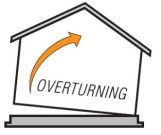
These high wind failures can be prevented or effectively lessened when a home is well-connected with the right amount of nails and metal connectors. The key connections to reinforce include the roof-to-upper story; upper story to first floor; and house to foundation. When you make these connections the right way, you will have a continuous load path that ties your home together from the roof to the foundation.
If you are getting ready to build a new home, remember, it is possible to build a hurricane-resistant home from a variety of materials, including wood, engineered wood, and concrete products like concrete block, insulated concrete forms, cast-in-place concrete, and more. Many materials provide the additional benefits of durability, energy savings, and sustainability, so it’s important to research all of your options before you begin.
 Windborne debris batters and breaks windows, doors, and garage doors, but this can be prevented by using impact-resistant windows and doors, or tested and approved hurricane shutters. Shutters can be permanently installed, or temporarily. Even the proper thickness of 5/8” plywood cut to fit each window and opening is effective if properly mounted with the right fasteners. Click here to view our videos about hurricane shutters, impact-resistant windows, and how to make temporary, emergency panels.
Windborne debris batters and breaks windows, doors, and garage doors, but this can be prevented by using impact-resistant windows and doors, or tested and approved hurricane shutters. Shutters can be permanently installed, or temporarily. Even the proper thickness of 5/8” plywood cut to fit each window and opening is effective if properly mounted with the right fasteners. Click here to view our videos about hurricane shutters, impact-resistant windows, and how to make temporary, emergency panels.
Wind-driven rain can be kept out of your home if you refresh the caulk around your windows and the flashing around doors at least once per year. Hurricane shutters will also help prevent this damage.
 Rising waters flood inside homes, damaging appliances, electrical systems, flooring, and more. Click here to use this calculator and see the potential damage to your home from flooding. What you’ll learn is that only four inches of water can cause nearly $30,000 in damage.
Rising waters flood inside homes, damaging appliances, electrical systems, flooring, and more. Click here to use this calculator and see the potential damage to your home from flooding. What you’ll learn is that only four inches of water can cause nearly $30,000 in damage.
The best financial protection from flood damage is flood insurance, but you must purchase a separate policy as it is not part of your homeowner’s insurance coverage. Also, flood policies carry a 30-day waiting period, so it is important to secure your protection now before the hurricane season begins.
In addition to flood insurance, there are many steps you can take to minimize flood damage. This animation provides a comprehensive overview, and here are some examples:
- Elevate electrical outlets
- Anchor fuel tanks
- Install a floating drain
- Elevate appliances inside and outside
It is also important to keep your gutters and downspouts around the home clear of debris, so they can carry the water away from your foundation.
If flooding is imminent, you should secure sandbags. If they are properly filled, placed, and maintained, sandbags can redirect storm water and debris flows away from a home and other structures. Follow the guidance below to make sure you use and then dispose of them correctly.

Filling:
- Fill sandbags one-half full.
- Use sand if readily available, otherwise use local soil.
- Fold top of sandbag down and rest bag on its folded top.
Placing:
- Take care in stacking sandbags.
- Limit placement to three layers unless a building is used as a backing or sandbags are placed in a pyramid.
- Tamp each sandbag into place, completing each layer prior to starting the next layer.
- Clear a path between buildings for debris flow.
- Lay a plastic sheet in between the building and the bags to control the flow and prevent water from seeping through openings like sliding glass doors.
Limitations:
- Sandbags will not seal out water.
- Sandbags deteriorate when exposed to continued wetting and drying for several months. If bags are placed too early, they may be ineffective when needed.
- Sandbags are for small water flow protection up to two feet. Protection from larger flow requires a more permanent flood prevention system.
- Wet sandbags are very heavy and caution should be used to avoid injury.
It is important to consult your local environmental protection department before disposing of used sandbags. Sandbags exposed to contaminated floodwaters may pose an environmental hazard and require special handling.
Storm surge and waves are often the most destructive threats to homes in the path of a hurricane. So, whether you live near the coast where storm surge is possible, or you are inland where rising waters from heavy rains threaten, it is best to build or buy a home that is elevated above the Base Flood Elevation (BFE) or the expected level of flooding established by the FEMA flood maps.
No matter where you live, the best protection from hurricanes or any natural disaster is to ensure that your home is constructed to meet or exceed current building codes. Post-disaster investigations have proven again and again that homes built to code have the best chance of surviving. And when you have a strong home that survives the wind and the water from hurricanes, you will become resilient in the face of the storm.
Assemble Disaster Supplies
Go Shopping. Now.
Dr. Rick Knabb
Former Director, National Hurricane Center
@NWSNHC
How awful is the aftermath of a hurricane? An individual’s experience can range from a tolerable inconvenience to a life-altering disaster, but awful generally covers it. If we could teleport ourselves into that situation for just a few moments, the items we desperately need would quickly become obvious, and we’d probably have no trouble making our shopping list for hurricane supplies. It’s hard to truly feel that level of desperation when it’s just a bad daydream, but fantasize reality we must if we’re going to understand why it’s so important to stock up on critical supplies – in advance rather than waiting until a hurricane is actually out there and threatening.
Up front, I’ll stipulate that not everyone can financially afford to stock up in advance like this. So, those of us with the means to do so have an even greater responsibility to shop now and be self-sufficient in the days following the storm. If we don’t, then we are unnecessarily taking up space in the last-minute long lines at stores during a hurricane warning and at emergency distribution centers in the aftermath. Some of us could even go a step further and directly help a less fortunate neighbor that we personally know to obtain the most critical supplies, or we could donate to a nonprofit organization that might be able to make that happen.
Stocking up on hurricane supplies is, after all, mostly not about convenience. Some items really do fall into the category of essential for survival and returning life back to “normal” as soon as possible. We really need think carefully about what we’ll need to survive for days with the power out and in isolation from emergency responders because roads are blocked by debris or floodwaters and they’re applying their resources to other hard-hit areas. The list of absolutely essential hurricane supplies has to include at least the following items in my top ten:
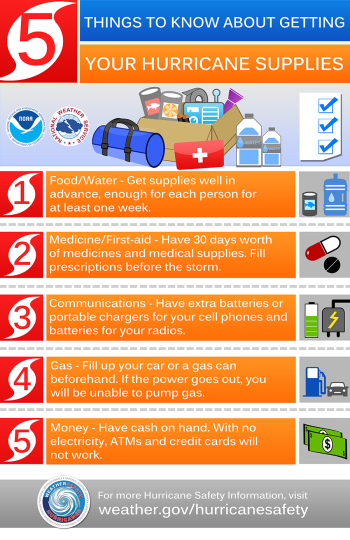 Bottled water. I’d shoot for at least one gallon per person, per day, for at least seven days.
Bottled water. I’d shoot for at least one gallon per person, per day, for at least seven days.- First aid kit. This is even more crucial than at first glance. Maybe, for example, you get through the storm unscathed, but what if you are injured while emergency responders cannot reach you? Even worse, what if it’s your child?
- Prescription medications. Fill these before the storm since the pharmacies might not reopen for quite a while. For some of us with serious conditions, it’s simply not a viable option to miss a dose.
- Over-the-counter medications. Think beyond basic pain relievers to include all kinds of remedies for ailments that might not be a big deal when the drug stores are open but that could worsen without any treatment.
- Non-perishable foods. You’ll need enough for your entire family for a minimum of one week. Get as many of those convenient pop-top opening cans as you can find, but always have a manual can opener. It’s really embarrassing during a power outage to push the lever on an electric can opener over and over and wonder why it’s not working.
- Formula, diapers, and other baby supplies. This obviously does not apply to everyone, but it wasn’t that long ago that my wife and I had an infant in our home during an actual hurricane – so trust me, these are not the kinds of supplies you want to be racing to scoop up at the last minute. There are too many other parents that will be faster than you in getting to the stores and clearing out the shelves.
- Battery-powered AM/FM/NOAA Weather Radio. If possible, get one that also receives the audio from local television stations. Don’t cut yourself off from potentially life-saving information.
- Batteries. This is for everything with an on/off switch that can operate without a cord, and not all of these are just for fun. Start with noting what size batteries your flashlights take.
- Toiletries. ‘Nuff said, except I’ll say that an often-overlooked item is moist towelettes.
- A waterproof and fireproof container. Store in here your priceless photos and important papers, including insurance policies and documentation of your home’s contents that you’d need for an insurance claim.
Elaborating on non-perishable foods, I’m always on the hunt for out-of-the-box thinking on what to eat in the aftermath of a hurricane. I love having an excuse to eat nothing but potato chips and peanut butter sandwiches as much as the next guy, but things don’t have to be so elementary school. If you have a gas grill in the backyard, get an extra tank and fill it up this weekend. You’ll thank yourself later, with or without a hurricane this year. Your summer holiday weekend cookout will hit a major snag if you run out of propane, without a spare, before you’ve flipped the burgers over. If a hurricane does strike and your electric stove goes out of commission, your gas grill – especially if it has one of those side burners – will be a valued friend. If you’ve stocked up on water, you can cook non-perishable foods like pasta. A simple hot meal will be an exquisite luxury in the days after a hurricane.
Our society’s increased reliance on technology has forced us to expand our list of emergency supplies as compared to years past. Have you thought about all of the modern conveniences that are not going to be functioning when the power is out – possibly for days or even weeks – after a hurricane? Here are my top five technology-driven hurricane supplies:
- Cash. It will quite literally be king when the ATM screens are dark and swiping a credit card accomplishes nothing during an outage. And put some under the proverbial mattress way in advance if you can, so that you can avoid ultra-long lines in an actual hurricane event.
- Gas for the car. Fill up as far in advance as reasonably possible. In past hurricane approaches, I’ve filled up in the middle of the night just before the storm. I wasn’t the only one with the idea, so there was some safety in numbers, but I avoided the longest lines and it saved a lot of time the next day to focus on other preparations.
- Offsite data backups. This is no longer just a problem for computer geeks like me. How many important records, family photos, and other irreplaceable files are stored on your laptop, desktop, or mobile device? Not only can a hurricane (or other weather disaster) take out both your computer and your backup disk in one fell swoop if they’re both stored at home, so can a fire, a robbery, or disk drive failures. You could store a backup disk at some other location in town, such as a safety deposit box. Another option is online backup services to which you upload your data.
- Solar-powered USB chargers. The first person in my household to not only find out about but also own one of these was my 11-year-old son. When I asked him, “why do you need one of those?”, he said, “Daddy, it’s really cool. Plus, it’ll be really good for our hurricane supplies.” He’s already saved the day with that thing when my phone was out of power one day at the beach. Many of these chargers can also be powered up via an electrical outlet before the storm. Variations on the same theme include cell phone and USB chargers powered by conventional batteries.
- This is not in everyone’s budget, but this article would be incomplete without mentioning generators, whether they be portable or permanently installed. I can’t emphasize enough, however, that you must NEVER operate a generator indoors. Carbon monoxide poisoning has wiped out entire families.
Patience can be in short supply after a hurricane, but a little advance planning can help you and your family – especially the kids – to endure the potentially lengthy aftermath. Assemble their favorite pillows and blankets, sleeping bags, books, and board or card games (especially if evacuating). Reading to your younger kids might be one of the most enjoyable ways to help them pass the time.
I’ve referred in this article to hurricane supplies, but they’re important to have on hand for any natural or man-made disaster that might force you to survive on your own for many days.
Here are a couple of supplies to NOT put on your hurricane season shopping list:
- People have died in fires during power outages after leaving candles unattended. See batteries and flashlights above.
 Tape for windows. In all seriousness, Go Tapeless. Tape does not keep your windows from breaking, so you’d be wasting your time and money. Even worse, tape serves to make the broken pieces larger and deadlier. People have died standing behind windows or glass doors with a false sense of security.
Tape for windows. In all seriousness, Go Tapeless. Tape does not keep your windows from breaking, so you’d be wasting your time and money. Even worse, tape serves to make the broken pieces larger and deadlier. People have died standing behind windows or glass doors with a false sense of security.
If your season ends up being hurricane free, have a party in December, and eat and drink your hurricane supplies so they don’t eventually expire and go to waste. You can restock your supplies once per year. Search online to see if your state offers sales tax exemptions for a few days each year on hurricane preparedness items, sometimes on big-ticket purchases like generators.
I’m sure I haven’t thought of everything, but hopefully this has created in you a severe brainstorm that will ultimately leave you better prepared for not only the storm itself but the awful aftermath. For more details on what you might need in your supply kit, visit www.ready.gov/kit.
Secure an Insurance Check-Up
Put an Insurance Review on Your Hurricane Prep To-do List
Jeanne M. Salvatore
Senior Vice President and Chief Communications Officer, Insurance Information Institute
@JeanneSalvatore / @iiiorg
Most people don’t put insurance on their hurricane preparedness checklist. But they should! Having the right amount and type of insurance is a crucial component of disaster preparedness. And the good news is that it only takes one simple step – a call to your insurance professional.
Making sure you understand all your insurance options and updating insurance coverage should be as routine as an annual physical. Think of it as a way to maintain a healthy financial future if a natural disaster were to strike.
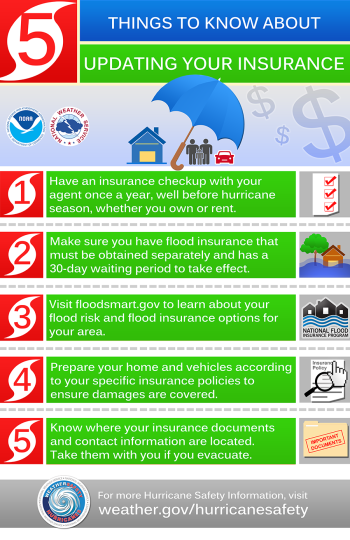 Prior to a conversation with your insurance professional, take a few minutes to write down all of your insurance questions. Or even better, pull out and read your current insurance policy. This is bound to lead you to more questions, and that’s a good thing.
Prior to a conversation with your insurance professional, take a few minutes to write down all of your insurance questions. Or even better, pull out and read your current insurance policy. This is bound to lead you to more questions, and that’s a good thing.
An important partner in hurricane preparedness is an insurance agent or company representative who is willing to answer all of your questions and clearly explain what is covered and what is not. If he or she can’t answer questions to your satisfaction, find another insurance professional. Insurance is a very competitive business, and there are many insurers who would like to deliver top-notch service to you and your family.
Know which disasters are covered in a homeowners policy and which are not. Wind damage is covered, no matter if the cause is a tornado, catastrophic hurricane or just a summer storm. When a wind blows, it is going to be covered by standard home and business insurance policies. Keep in mind that in most coastal states there is both a standard deductible and a hurricane deductible. The former is a flat dollar amount, such as $1,000, while the latter is typically a percentage of the insured value of your home.
The one big hurricane-related disaster that is not covered by standard policies is flooding. Fortunately, flood insurance is available from the National Flood Insurance Program (NFIP) and from a few private insurance companies.
 Did you know that 90 percent of all natural disasters involve some form of flooding? That is reason enough for everyone to consider flood insurance. And don’t be lulled into the false notion that only areas bordering large bodies of water get flooded. Floods can occur wherever it rains, and at least 20 percent of flood claims are paid to people who live in low- to moderate-risk flood zones. In general, the lower your flood risk, the less you pay for protection. Learn more about your risk of flooding and the estimated cost of an NFIP flood insurance policy by going to www.floodsmart.gov.
Did you know that 90 percent of all natural disasters involve some form of flooding? That is reason enough for everyone to consider flood insurance. And don’t be lulled into the false notion that only areas bordering large bodies of water get flooded. Floods can occur wherever it rains, and at least 20 percent of flood claims are paid to people who live in low- to moderate-risk flood zones. In general, the lower your flood risk, the less you pay for protection. Learn more about your risk of flooding and the estimated cost of an NFIP flood insurance policy by going to www.floodsmart.gov.
I always remind people that in addition to the right kind of coverage, they also need the right amount of insurance. What that means is having enough insurance to completely rebuild your home and replace all its contents. Rebuilding costs are often a lot higher than a home’s real estate or market value, because the costs of building materials and labor continue to rise.
Be smart. Be ready. Ask questions. Give yourself confidence that your insurance is up to date and ready to protect your financial future – before hurricane season starts. For more information on insurance, visit the Insurance Information Institute’s website at www.iii.org.











